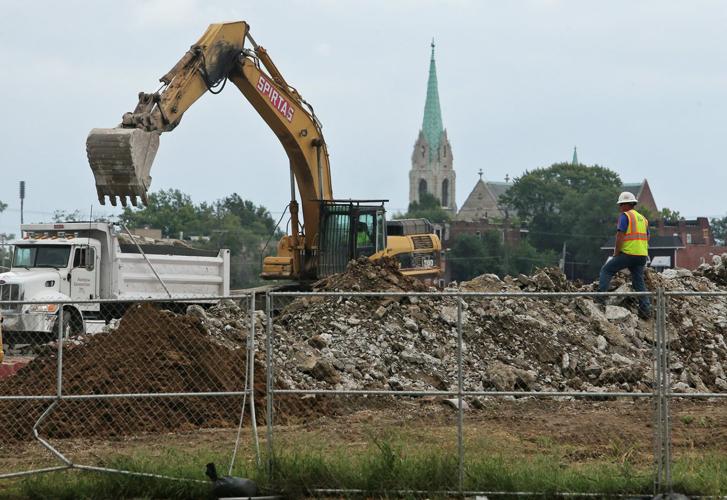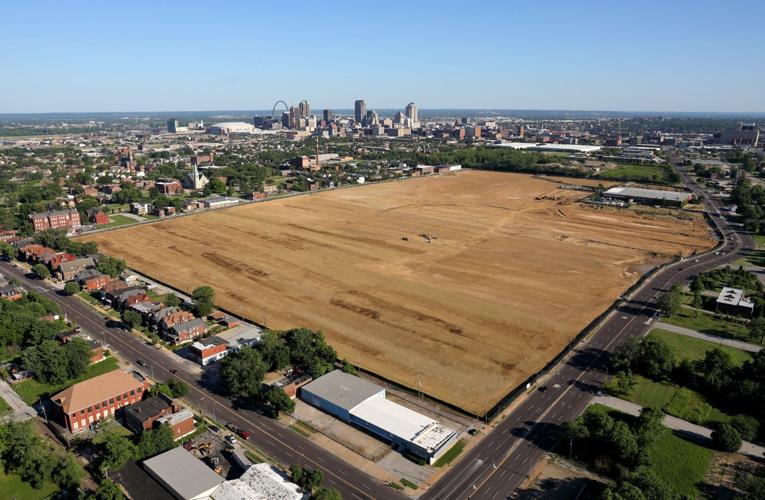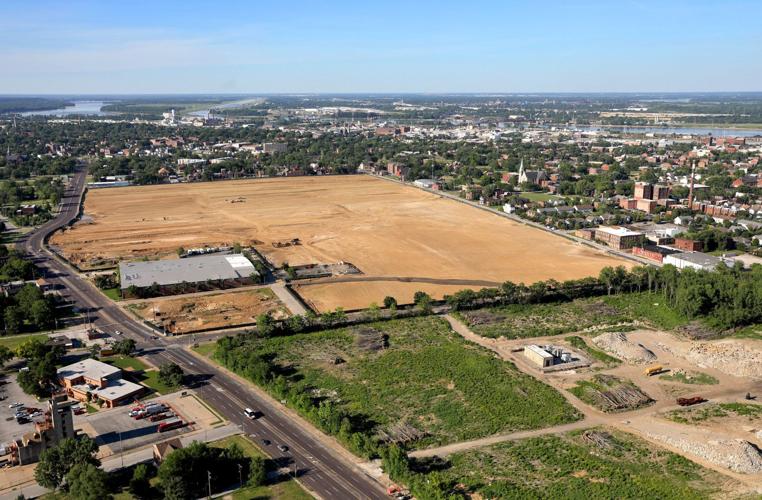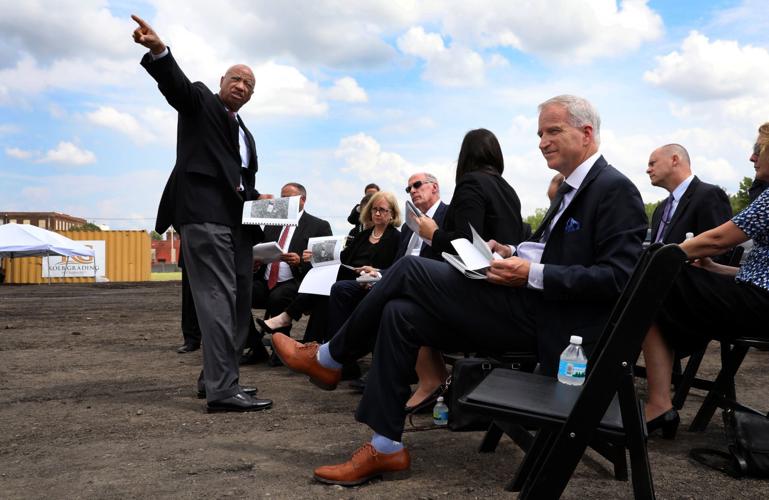ST. LOUIS ŌĆó City officials announced Friday that they had finalized the transfer of 97 acres north of downtown to the federal government for the construction of the National Geospatial-Intelligence AgencyŌĆÖs $1.7 billion western headquarters, capping nearly four years of work assembling the site for one of the cityŌĆÖs largest economic development projects in decades.
ŌĆ£WeŌĆÖre all excited. We are thankful for all the help along the way from both the public and private sector and a great deal of support from the state of Missouri,ŌĆØ said ├█č┐┤½├Į Development Corp. Director Otis Williams, who shepherded the project for the city first under former Mayor Francis Slay and now Mayor Lyda Krewson. ŌĆ£This was a huge undertaking. ItŌĆÖs a sigh of relief to get it all done.ŌĆØ

NGA Director Robert Cardillo (right) looks on as Otis Williams, executive director of the ├█č┐┤½├Į Development Corporation, leads a tour of the new location of the National Geospatial-Intelligence Agency headquarters near 23rd Street and Cass Avenue on Friday, Aug. 17, 2018. From left are Williams, ├█č┐┤½├Į Mayor Lyda Krewson, Director of National Intelligence Dan Coats, Deputy Under Secretary of Defense for Intelligence Kari Bingen and Cardillo. Photo by Robert Cohen, rcohen@post-dispatch.com
City officials fought hard for years to retain the NGA, which employs some 3,100 people in a facility on the Mississippi riverfront near the Anheuser-Busch brewery. FridayŌĆÖs announcement is a major milestone in a project that even as recently as this summer appeared potentially at risk.
People are also reading…
The official transfer will happen in the coming weeks as top officials complete documents and agreements. This spring, the Army Corps of Engineers, which is overseeing the construction, plans to pick a general contractor from three finalists. Construction could start by late 2019, with the facilityŌĆÖs completion anticipated in 2024 or 2025.
The city will hand off a cleared site to the federal government in the fall, and three firms are vying for to build the huge facility.┬Ā
Since the NGA decided in 2016 to build on the cityŌĆÖs north side, ├█č┐┤½├Į has spent more than $114 million to buy hundreds of properties, build a new facility for an industrial laundry company, demolish buildings, clear the land and grade it. There have also been legal costs for eminent domain for those owners who didnŌĆÖt wish to sell, and last-minute court tussles over the summer with the developer and bank that started the whole project, Paul McKee and the Bank of Washington.
The complex financing relied on strong support from the Missouri Department of Economic Development, which started under former Gov. Jay Nixon and into the current administration, and bond underwriting professionals at Stifel, Williams said.
The costs will ultimately be repaid with city earnings taxes and state income taxes from the NGA employees, a worthwhile expense, officials say, for a major project in an area that needs investment and a far better alternative than losing the jobs, as initially feared.
The National Geospatial-Intelligence Agency plans to build its new Western Headquarters in the city, keeping a decades-long relationship with ├█č┐┤½├Į and solidifying the spy agency's move into the digital era.
As the federal intelligence agency looked for a site to build a headquarters for its second-largest facility, ├█č┐┤½├Į officials were up against counterparts in St. Clair County, who offered an open field ready for development near Scott Air Force Base as an alternative.
Both Republicans and Democrats on the Missouri side of the regionŌĆÖs Congressional delegation lobbied for the project but faced an Illinois Congressional delegation with members close to former President Barack Obama, a former Illinois senator.
ŌĆ£When it first came up, it was looked at as a long shot,ŌĆØ Williams said. ŌĆ£I was told many times that you guys donŌĆÖt have a chance. I told folks that we were in this to win it. We went all out.ŌĆØ
Ultimately, NGA leaders indicated a desire to stay in the urban core as a way to recruit tech talent and attract private companies that support the agencyŌĆÖs mission. That, coupled with what some saw as the Obama administrationŌĆÖs commitment to urban renewal, allowed the city to retain the facility despite the daunting task of buying out dozens of property owners and clearing land that had held generations of residents.
In a statement, NGA Director Robert Cardillo called it a ŌĆ£historic day.ŌĆØ
ŌĆ£Building upon our history in ├█č┐┤½├Į, the new campus in North City will enable NGA to deliver our mission through the end of the century and beyond,ŌĆØ he said. ŌĆ£We look forward to continue teaming with the talent and innovation of the ├█č┐┤½├Į region.ŌĆØ
Development in the area would be the most significant project in memory on the cityŌĆÖs North Side, which has long struggled from disinvestment.
Mayor Lyda Krewson pointed to the planned facilityŌĆÖs proximity to downtown, area universities and the Cortex tech district, which will help grow the cluster of geospatial and mapping technology jobs in the region that support and are supported by the NGAŌĆÖs workforce and contractors.
ŌĆ£NGA is like any other employer, and their goal is to attract and retain talent,ŌĆØ she said. ŌĆ£What weŌĆÖre looking to do through the startup community, the tech community, is to support the businesses in the area and the residents in the area to make sure thereŌĆÖs good development in and around the area.ŌĆØ
Troves of public documents recently obtained by the Post-Dispatch, and interviews, tell of a development deal that nearly came apart, but ended up keeping 3,000 jobs in the city.
Williams gave credit to developer Paul McKeeŌĆÖs NorthSide Regeneration, which had assembled over half of the site from private owners and the cityŌĆÖs land bank. McKee initially submitted a response to an RFP from an undisclosed entity looking for a site, which later turned out to be the NGA.
Once it became clear it was the NGA and the north ├█č┐┤½├Į site was in play, the city ŌĆ£brought the resources and coordinationŌĆØ necessary for the project, Williams said, taking over responsibility for assembling the remainder of the land.
Negotiations with McKee stretched on for more than a year prior to the NGAŌĆÖs 2016 announcement it would stay in the city, as the two sides jockeyed over price for the site and a third party bought up McKee debt and threatened foreclosure.
McKee and the city reached an agreement in 2016, but the relationship soured again this spring when the city terminated McKeeŌĆÖs development rights on his massive NorthSide Regeneration footprint in the area after questionable state tax credit transactions.
The city has sought to make doubly-certain the real estate for the $1.7 billion NGA project can be transferred to the federal government next month.┬Ā
That triggered lawsuits from McKeeŌĆÖs lender, the Bank of Washington, seeking to void agreements with the ├█č┐┤½├Į economic development agencies, which attorneys for the city offices said could ŌĆ£blow it up for everyoneŌĆØ and result in liens on a federal intelligence facility.
Ultimately, WilliamsŌĆÖ departments went to court to resolve the issue, and, at the Department of JusticeŌĆÖs request, the city took the unprecedented step of using eminent domain on land already owned by its economic development arm in order to clear any claims from the Bank of Washington. The lawsuits are ongoing, although the risk to the city now is only monetary damages, not the rights to land the federal government will soon own.
ŌĆ£I have not worked on anything that has been as complex and with as many requirements that we needed to approve and accomplish,ŌĆØ said Williams, who has a decadeslong career in economic development. ŌĆ£This is just one you can imagine every day there was something new that we needed to solve and resolve.ŌĆØ
















